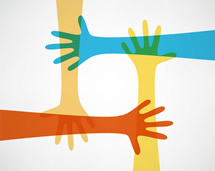
When it comes to social media in schools, most students don’t hesitate to collaborate with one another. But some schools and districts still worry about safety and responsible use. A new infographic lays out just how frequently, and in what ways, social media is being used in the classroom.
Ninety-six percent of students with internet access said they use social networking technology, and 56 percent of those students talk about education-related topics while they’re online. Fifty percent of students who use social networking to talk about education said they talk specifically about schoolwork.
Between 2004 and 2009, the amount of time that kids ages 2 through 11 spend online has increased by 63 percent. Three-fourths of students in grades 7-12 have at least one social media profile.
(Next page: How many schools and districts encourage students and teachers to use social networking?)Fifty-nine percent of schools said their students use social networking for educational purposes, 27 percent of schools have an online community for teachers and administrators, and 35 percent of schools have blogs run by students and/or educators. Forty-six percent of schools participate in online pen pal or similar programs, and 49 percent of National School Boards Association schools participate in online collaboration with other schools. Still, 69 percent of U.S. high schools have banned cell phones.
When it comes to using social media in schools, educators say that they have access to a professional community of their peers, social media encourages collaboration and promotes the exchange of ideas and best practices, they are exposed to ed-tech ideas on a regular basis, they are encouraged to participate in professional development, and inter- and cross-cultural dialogues are promoted.
Parents said social media in schools helps them become more involved in the classroom and curriculum, helps them understand the teacher’s expectations, increases school and district transparency, and increases teacher-student communication.
Social media helps students learn collaboration and develop important 21st century and workforce skills, gives them a positive view of technology, stimulates engagement and deeper understanding of school materials, increases “academic” networking, and has a positive influence on students’ school activities.
On Facebook, students and parents can view and access teacher-posted homework assignments. Students can post questions about assignments or class materials for their peers to answer, and parents and teachers can communicate directly.
Using Twitter, teachers can tweet reminders about class assignments, tests, or field trips. Students can discuss assignments and review lessons, and can create hashtags relevant to projects or other lessons for easy referencing.
- 4 ways to support work-based learning - April 23, 2024
- Prioritizing inclusivity in game-based learning - April 22, 2024
- Friday 5: Universal Design for Learning - April 19, 2024

Comments are closed.